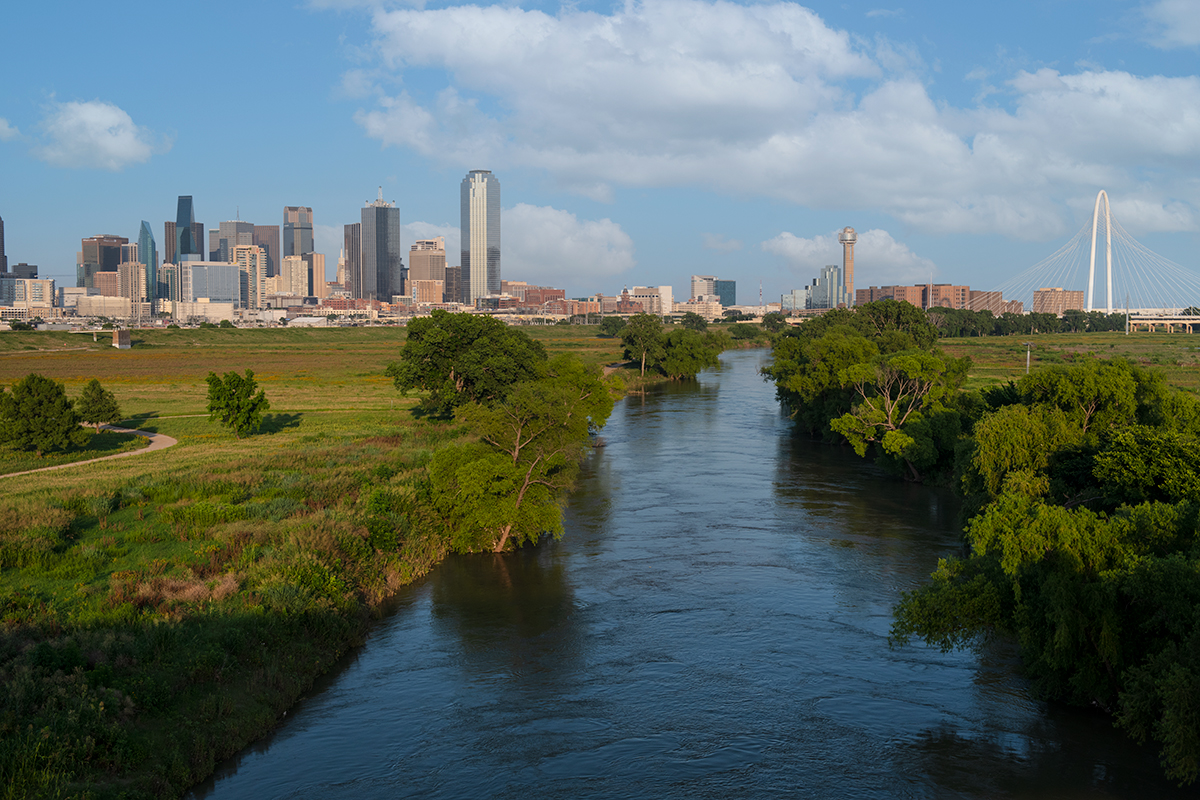A lifetime ago, in 2016, then Mayor Mike Rawlings stood before TV cameras on the third floor of the Italian restaurant Saint Rocco’s, in Trinity Groves. Large windows behind him overlooked the Trinity River levee and the Margaret Hunt Hill Bridge, with its Texas and American flags waving in a stiff breeze. Rawlings announced that Annette Simmons, widow of billionaire Harold Simmons, had promised $50 million toward an imagined $250 million, 155-acre Harold Simmons Park to be built in the Trinity floodway. Rawlings said that making the announcement was one of the high points of his tenure as mayor and that he wanted the park built “sooner versus later.” Renowned landscape architect Michael Van Valkenburgh had already drawn up plans. The gift came with a condition. The total construction cost had to be raised within three years. But the following year, the Dallas City Council killed a long-running scheme to build a tollway between the levees, and it looked like progress was at hand: no toll road, a great park plan, real timelines, and plenty of philanthropic dough to back up the effort.
That’s why I was surprised by what Ben Sandifer told me a few months ago. He’s an avid Trinity Forest explorer and unofficial watchdog. I casually mentioned the Harold Simmons Park in an email exchange with him. Sandifer has never taken his eyes off the Trinity. There’s a public board called the Trinity River Corridor Limited Government Corporation (LGC) that oversees the project. Before the board moved its business online, Sandifer often found himself the lone figure in the audience at its meetings.
“The Trinity weighs heavier on me every day,” Sandifer wrote. “Things seem to have deteriorated to the point where the LGC and their contractor, the Trinity Park Conservancy, will need to start over from scratch. That includes new contracts with the City Council and a new timeline for starting work on the recreation area between the levees.”
What had happened? The Trinity Park Conservancy, the nonprofit charged with constructing the park, appeared to be clipping through milestones. It unveiled new renderings created by the Van Valkenburgh firm, commissioned economic impact studies, and engaged in conversations with communities about how to design a park that is equitable and inclusive. The Conservancy also bought land along the levees, and, with help from the developer Jack Matthews, it gained control of the old Jesse R. Dawson State Jail, which it hopes to radically reimagine and incorporate into levee-top parks that will overlook a reconstructed Trinity floodway. And in April, the Conservancy hired a new director, Tony Moore, the former executive director of Tulsa’s Gathering Place, a nationally acclaimed riverside park also funded through private philanthropy and designed by Van Valkenburgh.
But as I began to dig through the video archives of the LGC meetings, I found that the most impactful Trinity news of the past half-decade had gone largely unnoticed. In 2018, a year after Hurricane Harvey had dumped record rainfall on southeast Texas, the Trump administration allocated $5 billion for Texas flood control projects, including $275 million for improvements to the Trinity River levee system. Over the next six years, the U.S. Army Corps of Engineers will oversee more work here than has been done on the levees since they were completed in the 1930s.
The scale is staggering. The Corps will construct two new levees south of downtown, along Lamar Street and the Cadillac Heights neighborhood, on the east and west sides of the river, respectively. It will also expand the existing levee next to downtown where the Conservancy hopes to build its east overlook park. During construction, among other entry points, crews will access the Trinity via the west levee, where the Conservancy is planning another overlook park. To build the new levees, the Corps plans to dig large soil borrow pits in the floodway precisely in the location of the future Harold Simmons Park. There are also plans for new pump stations. The Corps has suggested to the LGC that while all this is taking place, the city should wait for the completion of the floodway control project designs before moving forward on Van Valkenburgh’s designs, lest the Conservancy waste any money on unusable plans for the park.
How long will this work delay the park? No one really knows. The Corps is still in the early stages of design. Until that’s complete, the Conservancy can’t move forward on its own designs. The Conservancy told me it has broken up the Harold Simmons Park into phases so that it can begin to design aspects of the project as the Corps’ plans take shape. It hopes to break ground on the east overlook park within 19 to 25 months.
That might be optimistic. Sarah Standifer, assistant director of Dallas Water Utilities, who has long been a lead city staff member on the Trinity River Project, told me it was still too early to know when park design or construction could begin, but she said she hopes the Corps will complete its initial designs in the coming months and a timeline will shape up by the end of the year. A spokesperson for the Corps offered the firmest deadlines: it expects to complete the earliest components by 2024, with the full project wrapping up around 2027.
So even if the Conservancy can build Harold Simmons Park in phases, it won’t be completed until at least a decade after the 2020 groundbreaking the Conservancy announced two and a half years ago—and some 30 years after the 1998 bond election that gave rise to the modern incarnation of the Trinity River Project. As Ben Sandifer pointed out to me, there are voting-age residents in Dallas today who weren’t even born when Dallas held that bond election and began the arduous process of building a park in the Trinity floodway.
The Conservancy points out that these delays are out of its control, and it sees the Corps’ floodway improvements as beneficial to the park. Getting a generation’s worth of flood control improvements completed now eliminates the potential for future Corps work to impact the park post-construction. And there may be opportunities for savings by coordinating with the Corps during construction; digging up dirt for the new levees could create topographic features that Van Valkenburgh could work into the park design.

But the longer the park planning process is delayed, so, too, is the rigorous Corps approval process to ensure that the Van Valkenburgh design adheres to federal guidelines for floodplain construction. In other words, we still don’t know if those renderings that have been circulating for five years can actually work in a floodway, and we won’t for some time. The delays also make fundraising more difficult. As of July, the Conservancy says it has secured $112 million in pledged donations (including the Simmons grant), with an additional $5 million committed verbally. But board member Deedie Rose told the LGC last year that fundraising will essentially cease until there are firmer plans and timelines for the park.
A plan for funding park operations and maintenance is also not set in stone. An economic study estimated park operations to cost roughly $200 million over the first 20 to 30 years. The Conservancy plans to raise a $25 million endowment for maintenance, and it hopes that the two overlook parks will provide opportunities for programmable events spaces, restaurants, and other amenities that can generate revenue for the park. But the Conservancy also hopes to pursue public funding in the form of a tool like a Tax Increment Financing or Public Improvement District, and there is no guarantee that, 20 years after voters approved the bond package, elected officials will be willing to steer more public dollars toward a Trinity park promised with solely private donations.
The notion of a park in the Trinity River floodway, since its inception, has always been at odds with an inconvenient reality: that large green space between the levees is not a blank slate; it is a functioning flood mitigation tool with a delicate ecology. That disconnect between the nature of the Trinity floodway and the myriad visions imposed on it has contributed to the Conservancy’s track record for running over cost and falling short of expectations. The Conservancy is a reincarnation of the Trinity Trust, the organization that raised funds for the Margaret McDermott Bridge. Botched construction of its pedestrian path cost the city $7 million to fix before it finally opened in June, four years behind schedule. The Trinity Trust was also behind a whitewater kayak course in the river that turned out to violate federal law; it cost $4 million to build and an additional $2 million to tear out.
In background conversations with individuals involved with the project, I’ve sensed an expectation that a renegotiated Conservancy contract would establish more open-ended delivery timelines and loosen some of the approval powers of the LGC. That would be a mistake. The current delays may have been outside the Conservancy’s hands, but setting firm timelines doesn’t tie them. Those timelines and the strength of the public oversight of the project are essential to reestablishing public trust around the Trinity. And with so much uncertainty still swirling around, vigilant public oversight will ensure that one of the region’s greatest assets won’t go to waste if the Conservancy’s dream turns out to be a fantasy.
Write to [email protected]. This story appeared in the August issue of D Magazine with the headline “Under Water.”







